
|
![]()
Greatest Films of the 1930s
1930 | 1931 | 1932 | 1933 | 1934 | 1935 | 1936 | 1937 | 1938 | 1939
Title Screen Film Genre(s), Title, Year, (Country), Length, Director, Description 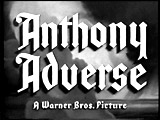

Anthony Adverse (1936), 141 minutes, D: Mervyn LeRoy
An intriguing, blockbuster film based on Hervey Allen's bestseller novel. A naive but ambitious youth Anthony Adverse (Fredric March) traveled through early 19th century America, Europe, and Africa (during the time of Napoleon), and matured to manhood and personal/financial success from his globe-trotting experiences. A grandscale film, with 98 speaking parts, thousands of Warner Bros. extras, and over 130 different sets. Notable as the first film to be honored with the newly-created Best Supporting Actress Academy Award (awarded to Gale Sondergaard).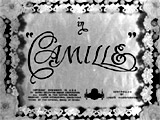

Camille (1936), 109 minutes, D: George Cukor
The film version of Alexander Dumas' novel which inspired Verdi's opera La Traviata - there were a number of silent film versions (and shorts), and many other variations, including the most recent musical by Baz Luhrmann, Moulin Rouge! (2001) This was the definitive version, with Greta Garbo's greatest performance in one of the best romantic films of all time. In 1840s Paris, Marguerite, "lady of the camellias" (Greta Garbo), a lovely Parisian courtesan (prostitute) was a kept woman of wealthy Baron de Varville (Henry Daniell). She fell in love with Armand Duval (Robert Taylor), a young innocent French nobleman, but then sacrificed herself for him when his father Monsieur Duval (Lionel Barrymore) asked her to give him up. With a classic, tearjerking death scene conclusion when she suffered from terminal TB (consumption) and Armand expressed his love for her as she died in his arms.


A Day in the Country (1936, Fr.) (aka Partie de Campagne), 40 minutes, D: Jean Renoir
A short, unfinished feature film based on a story by Guy de Maupassant, and set in the French countryside. A romantically-tinged, impressionistic, lyrical, sensuous and idyllic work of art. In the captivating story in the year 1860, hardworking Parisian shopowner Monsieur Dufour (André Gabriello) took his family for their annual summer country picnic, near Poulain's riverside inn. The group included his wife Madame Juliette Dufour (Jeanne Marken), pretty young daughter Henriette (Sylvia Bataille), the old grandmother (Gabrielle Fontan) and a young apprentice shop boy Anatole (Paul Temps), the dimwitted fiancee of Henriette. They had an afternoon meal under a cherry tree, fish, and boat. The young girl left the group and was briefly attracted to Henri (Georges D’Arnoux, or Georges Saint-Saens), although she was engaged and soon regretfully married buffoonish Anatole. Years later, she returned to the spot of their picnic and had a rendezvous with lovesick Henri - lamenting what happened.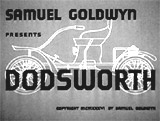


Dodsworth (1936), 101 minutes, D: William Wyler
Based upon the Sinclair Lewis novel. A self-made millionaire American auto tycoon, middle-aged businessman Samuel Dodsworth (Walter Huston) went from the midwest town of Zenith on a retirement trip to Europe with his frivolous, vain and shallow wife Fran (Ruth Chatterton), who was afraid of growing old. During the sailing, Fran showed her real colors by accepting the advances of Lothario Englishman Capt. Lockert (David Niven). In Europe, their lives and relationship were changed irrevocably when they realized they had irrevocably grown apart. She was entranced with the cosmopolitan lifestyle and had romantic flings with three Europeans (including Arnold Iselin (Paul Lukas)), announcing that she wanted a divorce to marry an impoverished Austrian nobleman, Kurt von Obersdorf (Gregory Gaye). Sam met and found peace, solace and love with a beautiful, expatriate American divorcee Edith Cortright (Mary Astor) and by film's end, left his self-absorbed, unapologetic wife to be with her in Naples. A mature and intelligent adult drama.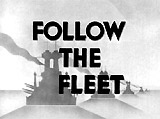


Follow the Fleet (1936), 110 minutes, D: Mark Sandrich
This is a delightful yet predictable RKO film about a double-romance - a delightful song/dance classic and the fifth of ten Astaire/Rogers films (and the first to take place entirely in the US). It began when song-and-dance-man, Bake Baker (Fred Astaire) enlisted in the Navy after being rejected by his ex-dance partner, Sherry Martin (Ginger Rogers) who he wished to marry two years earlier. Bake and naval sailor buddy Bilge Smith (Randolph Scott), who were on leave in San Francisco, romanced Sherry and her sister Connie (Harriet Hilliard, later Harriet Nelson), when they met in the Paradise Club dance hall. The estranged couple reconciled, and helped to solve the romantic difficulties between Bilge and marriage-minded Connie. With an Irving Berlin score, including "I'm Putting All My Eggs in One Basket," "We Saw the Sea," "Let's Face the Music and Dance," and "Let Yourself Go."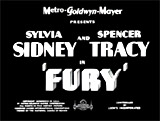


Fury (1936), 94 minutes, D: Fritz Lang
The first American film by expressionistic German director Fritz Lang, a realistic study of mob rule, injustice and revenge. A precursor to the film noir classics of the 40s and 50s. Set during the Depression era, Joe Wilson (Spencer Tracy) was about to marry fiancee Katherine Grant (Sylvia Sidney) when he was arrested by Deputy Meyers (Walter Brennan) on suspicion of kidnapping. He was innocent, although apprehended for having in his possession a $5 bill from the ransom money. Wilson was jailed in the small midwestern town of Strand, where a brutal, hysterical lynch mob attacked the jail and set it on fire, with Wilson inside and screaming for his life. Katherine fainted, unaware that Wilson escaped death and was determined to avenge his wrong with a frame-up. Wilson's two brothers spread the idea that the lynch mob should be tried for first-degree murder - and 22 townsfolk were indicted as defendants. Meanwhile, the real criminal kidnappers were caught, implying that Wilson was innocent all along. The case was tried by D.A. Adams (Walter Abel). In the trial, a newsreel proved that all of them were complicit and guilty of the crime - after they had given perjured testimony. One problem remained - Wilson's body was not recovered after the fire. Was he really dead? Katherine learned (and kept it secret) that Wilson was still alive (and in hiding watched the torment of the would-be vigilante murderers), although she still provided false testimony. When the embittered and vengeful Wilson realized that his frame-up had gone far enough, and that he had become a vindictive, one-man 'lynch mob' himself, he strode into the courtroom and confessed.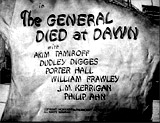


The General Died at Dawn (1936), 93 minutes, D: Lewis Milestone
An exotic adventure/melodramatic film set in the East in the 1920s, adapted from Clifford Odets' first screenplay. An American soldier of fortune O'Hara (Gary Cooper) smuggled gold across China to Shanghai to help finance arms purchases for a peasant uprising against a savage warlord General Yang (Akim Tamiroff). The cunning and evil Yang, who was interested in controlling all the northern provinces of China, attempted to have him assassinated, and when that failed, lured him onto a train en route to Shanghai. He was set up for an ambush and abduction when he fell in love with the daughter of one of Yang's agents, the beautiful spy Judy Perrie (Madeleine Carroll).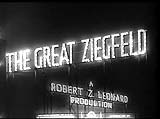



The Great Ziegfeld (1936), 170 minutes, D: Robert Z. Leonard
With lavish and grand dance production numbers, a Best Picture winner. The big-budget story was the fictionalized musical biography of the career of the flamboyant show business impresario Florenz Ziegfeld, Jr. (William Powell), including his relationships with wives, Anna Held (Best Actress-winning Luise Rainer) and Billie Burke (Myrna Loy) and co-workers. The film showed his rise from a sideshow barker to his world-famous New York "Follies." Filled with memorable cameos of the stars who actually appeared in the Ziegfeld Follies (Fanny Brice, Ray Bolger, Ann Pennington, Harriet Hoctor, and others.) With huge sets, especially for "A Pretty Girl Is Like A Melody," and other memorable songs including "Look For the Silver Lining," "If You Knew Susie," "Shine On, Harvest Moon," and "Rhapsody in Blue."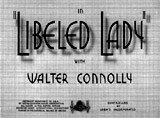

Libeled Lady (1936), 98 minutes, D: Jack Conway
One of the best classic screwball comedies of the 1930s. With a clever, fast-paced script, and another comic pairing of Powell/Loy from The Thin Man series. Remade as a musical titled Easy to Wed (1946). The newspaper of managing editor Warren Haggerty (Spencer Tracy) printed a libelous, false story about wealthy heiress Connie Allenbury's (Myrna Loy) affair with another woman's husband. She sued the paper for $5 million, just as Haggerty was preparing to marry fiancee Gladys Benton (Jean Harlow), one of his employees. The wedding was postponed. The scheming editor hired ex-employee Bill Chandler (William Powell) to marry (in name only) Gladys, so he could be free to seduce Connie, to trap her and prove the truth of the adultery story so the lawsuit could be dropped. But of course, the perfect plan failed when Chandler fell in love and married Connie.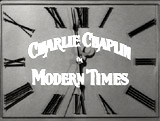

Modern Times (1936), 85 minutes, D: Charles Chaplin (also producer, actor, and writer)
One of the last great "silent" comedy masterpieces, with music, sound effects, and very limited gibberish dialogue/singing, and the last screen appearance of Charlie Chaplin's memorable character, The Little Tramp. Chaplin's next film after the successful City Lights (1931), about the dehumanizing and frustrating effects of the machine age - even in the 1930s. A factory worker (Charles Chaplin) went beserk and suffered a nervous breakdown, induced from the effects of working at a machine. He also suffered the effects of a labor strike, a jail sentence, and other problems of his modern age. Unemployed, he joined up with and fell in love with a young orphaned girl, the Gamine (Paulette Goddard, Chaplin's real-life wife).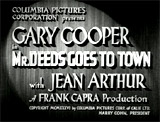

Mr. Deeds Goes to Town (1936), 115 minutes, D: Frank Capra
Both leads, Gary Cooper and Jean Arthur, also worked again with director Frank Capra in Meet John Doe (1941) and Mr. Smith Goes to Washington (1939). A charming comedy classic based on "Opera Hat" (Clarence Budington Kelland's Saturday Evening Post story). It contrasted small-town "little people" (populist) values with those of the cynical big city. An unassuming, eccentric small-town New Englander from Mandrake Falls, Vermont, a common-sensical greeting-card poet and tuba player, Longfellow Deeds (Gary Cooper), inherited a fortune of $20 million from his late uncle Martin Semple. The hick hayseed was brought to NYC by one of his relative's lawyers. He moved into an enormous mansion, but the guileless good-hearted Deeds quickly found that his world had been shaken in the heartless metropolis. He was immediately targeted by opportunistic city slickers - and so he attempted to give all of his fortune away by buying farmland, and giving plots (and a horse) to struggling farmers and needier unemployed people. A cynical and hardened news-reporter Babe Bennett (Jean Arthur) posed as a 'damsel in distress' to get his attention, exploited the situation and followed his story, and tried to figure out how he could be so generous. She had all the latest tabloid scoops when they became friends, and ended up falling in love with him. Deeds (who was also falling in love with Babe) was unaware of the press coverage. He was accused by his relatives who could not understand his generosity of being simple-minded, and they tried to commit him on insanity charges. Because of his harebrained scheme, Deeds was taken to court by sleazy lawyers for a competency hearing - and possibly to separate him from his money. In the hilarious hearing, witnesses testified about Deeds' unusual and peculiar behavior - two Faulkner sisters from Mandrake Falls, Amy and Jane (Margaret McWade and Margaret Seddon), claimed that Deeds was often "pixilated" (drunk?), and doodling German psychologist Dr. Emile Von Hallor (Gustav von Seyffertitz) stated that Deeds was manic-depressive. Eventually, love interest Babe came to Deeds' defense, stirring Deeds to take the stand and defend himself. He argued that he was no crazier than any of the others in the courtroom, and that there was nothing wrong with his philanthropic wishes. The judge ruled that Deeds was indeed sane, and he was triumphantly carried out by the crowd.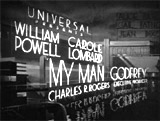

My Man Godfrey (1936), 94 minutes, D: Gregory La Cava
One of the first and best of the screwball comedies, a very zany, humorous classic, and biting satire about the idle rich. Remade in 1957 with David Niven and June Allyson. A group of extremely wealthy Park Avenue socialites held a scavenger hunt, and one of the participants, ditzy blonde heiress Irene Bullock (Carole Lombard) found a "forgotten man" at the dump for her list of odd items. The down-and-out, unemployed and homeless bum Godfrey Parke (William Powell) was in fact a blueblood who had a run of romantic bad luck - a product of the Depression. Back at the party in the hotel, the noble common man spoke to the crowd about the insensitivity of their quest. The flighty Irene gave him a job as the family butler and brought him home. In the wealthy, snobbish Bullock household run by nutty father Alexander (Eugene Pallette), Godfrey attempted to set things straight, taught the family a few lessons, and ultimately married Irene.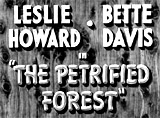


The Petrified Forest (1936), 83 minutes, D: Archie Mayo
A screen adaptation of Robert E. Sherwood's play, with Bogart reprising his stage role, and typecasting him as a gangster for the rest of his career. Vicious killer gangster Duke Mantee (Humphrey Bogart, in his first major, star-making movie role), fled from the authorities with his gang, and held out with a group of hostages at an Arizona desert roadside service station cafe, the Black Mesa Bar B-Q. Hostages included an idealistic, but disillusioned intellectual/writer Alan Squier (Leslie Howard) and the diner owner's daughter/waitress Gabrielle Maple (Bette Davis), an aspiring poet who dreamt of a better life and fell in love with him.



Rembrandt (1936, UK), 84 minutes, D: Alexander Korda
A colorful, unromanticized, complex biographical portrait of the last three decades of the life of 17th century Dutch master Rembrandt van Rijn (Charles Laughton). The little-seen, episodic period film followed the decline of his fortunes and artistic integrity, and his financial burdens of bankruptcy following the death of his first wife Saskia (unseen in the film). When female companionship with his sharp-tongued housekeeper Geertje Dirx (Gertrude Lawrence) was unsatisfactory, he scandalously married his pretty housemaid Hendrickje Stoffels (Elsa Lanchester). The film then followed his sorrow when his wife died, and his transition into senility and old age.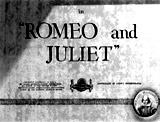


Romeo and Juliet (1936), 127 minutes, D: George Cukor
One of the best filmed versions of Shakespeare's tragedy/romance play, a grand MGM production by the studio's production chief Irving Thalberg. The star-crossed lovers from feuding families, the Montagues and the Capulets, were 13-year old Juliet (Norma Shearer, 31 years old, and Thalberg's wife) and the teenage Romeo (Leslie Howard, 49 years old). John Barrymore portrayed the colorful character of Mercutio. Remade many times afterwards, including Franco Zeffirelli's naturalistic Romeo and Juliet (1968), and Baz Luhrmann's updated and hip Romeo + Juliet (1996).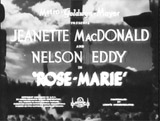


Rose-Marie (1936), 112 minutes, D: W.S. Van Dyke
An engaging musical (adapted from the Rudolf Friml-Herbert Stothart stage production) and the most famous of the movie operettas pairing the famous singing duo Nelson Eddy and Jeanette MacDonald. The first film version (although lost) was Rose-Marie (1928) with Joan Crawford as the title character, and it was later made with an entirely different story in Rose Marie (1954), starring Ann Blyth and Howard Keel. Opera star and singer Marie de Flor (Jeanette MacDonald) toured in Canada while she also hoped to appeal for the prison release of her brother John/Jack Flower (James Stewart, his second film early in his career). Then she was informed that her ne'er-do-well brother had escaped from prison and killed a Canadian Mountie during his breakout. When she went in pursuit of her brother in the rugged mountainous woods of Quebec Province in Central Canada, she met up with Canadian Mountie Sgt. Bruce (Nelson Eddy) who was tracking Flower and assigned to the case to pursue him in the wilderness. He saved her from drowning and helped her to survive in the great outdoors. He suspected that Rose-Marie was related to the fugitive because of their matching names - and thought that if he followed her, she would lead him to her brother - but at the same time, he unexpectedly fell in love with her during a famous love duet song: "Indian Love Call." In the film's conclusion when Sgt. Bruce apprehended Flower, he remained dutifully resolved to bring the fugitive to justice, but then became estranged from Rose-Marie even though he was in love with her. In the film's conclusion many months later, the depressed and emotionally anguished Marie (who had retired early from opera engagements) and Sgt. Bruce were joyfully reunited as they harmonized together on the "Indian Love Call."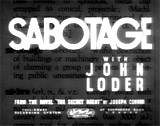

Sabotage (1936, UK), 76 minutes, D: Alfred Hitchcock
AKA as A Woman Alone, and an adaptation of Joseph Conrad's The Secret Agent. The film's tagline described the mystery thriller's plot simply: "...A Bomb Plot ...A Killing ...Justice." Foreign terrorist Mr. Carl Verloc (Oskar Homolka) was married to young American Mrs. Verloc (Sylvia Sydney, or Sidney) - both were the struggling owners of a London BIJOU cinema-theater. Verloc used his occupation in the movie theater as a front for his subversive activities. The saboteur was paid to be part of a plot to set off a bomb (hidden in a canary cage) in the Piccadilly Circus station - "the center of the world." He was being investigated by undercover Scotland Yard detective Sergeant Ted Spencer (John Loder). Unfortunately, the bomb killed Mrs. Verloc's unwitting younger brother Stevie (Desmond Tester) because he was unexpectedly delayed on a bus delivering the dangerous package with the bomb. [Note: Hitchcock was chastised and condemned for the scene of the killing of the innocent child.] Afterwards, the terrorists destroyed the theater to cover up their nefarious deeds. In a memorable, mostly silent scene at a dinner table, she found retribution and revenge by stabbing her husband in the stomach with a carving knife, and escaped having to confess to the crime because the theater (and all evidence) was burned down.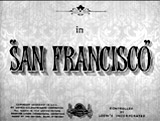

San Francisco (1936), 115 minutes, D: W.S. Van Dyke
An MGM lavish, big-star production and period drama, most noted for its spectacular special effects. It was the first big budget disaster film. Set on San Francisco's Barbary Coast in 1906, Paradise Saloon owner Blackie Norton (Clark Gable) fell in love with one of his recently-hired singers, beautiful Mary Blake (Jeanette MacDonald). She was also in great demand by operators of the city's opera house and wealthy Nob Hill socialite Jack Burley (Jack Holt), and a rivalry developed for Mary's attention. Priest Father Mullin (Spencer Tracy) of St. Anne's Mission was one of Blackie's boyhood friends who had followed a different path in life. The film ended with the famous 20-minute earthquake sequence.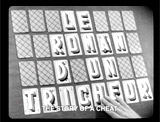

The Story of a Cheat (1936, Fr.) (aka Le Roman D'un Tricheur), 81 minutes, D: Sacha Guitry
A mostly-silent life story, told stylistically and with charm, of a cheat (portrayed by writer/director Sacha Guitry), related by voice-over narration as a series of witty flashbacked 'memoirs' spoken by the cheat himself at an outdoor cafe. During his youth, he escaped death at 10 years of age when everyone in his large family ate poisonous mushrooms - he didn't perish like everyone else, because he was being punished (and was forbidden to eat) after a petty act of stealing. He concluded that it didn't pay to be honest, and began a career as a cheat and scoundrel.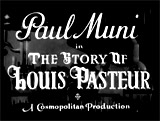

The Story of Louis Pasteur (1936), 85 minutes, D: William Dieterle
One of the best screen biographical dramas of the period, again starring Paul Muni - noted for his many performances in serious film biographies. A strong character study and historical portrayal of the famous 19th century French scientist and founder of bacteriology Louis Pasteur (Oscar-winning Paul Muni). He dedicated his life to develop the revolutionary, lifesaving anthrax vaccine and the toxin/antitoxin to cure rabies (hydrophobia), defying and challenging disbelieving doctors, conventional wisdom, ridicule, and skeptical Medical Academy colleagues.




Swing Time (1936), 103 minutes, D: George Stevens
A film classic made during the height of the Depression Era, with dancing/acting/singing from the greatest dancing couple ever, Astaire and Rogers. A young professional dancer and groom-to-be John "Lucky" Garnett (Fred Astaire) was engaged to his long-time girlfriend back home Margaret Watson (Betty Furness). He had come to New York to dance and earn $25,000 to prove that he could support his fiancee, but was sidetracked when he fell in love with beautiful dance academy instructor Penelope "Penny" Carrol (Ginger Rogers). A classic scene was the one in which Penny taught Lucky to dance! Thereafter, he did everything he could to avoid earning the money. Included the classic "Bojangles of Harlem" number, plus "The Way You Look Tonight," "A Fine Romance," "Pick Yourself Up," and "Never Gonna Dance."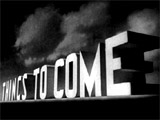


Things to Come (1936, UK), 100 minutes, D: William Cameron Menzies
An early sci-fi 'apocalyptic' visionary disaster film based on scripter H.G. Wells' novel, and basically asking the taglined question: "What will the next hundred years bring to mankind?" Noted for its production design (by William Cameron Menzies) and symphonic score. This talky landmark film predicted the future - from 1940 to 2036, and was first set in the fictional British city of 'Everytown' (a stand-in for London). At the film's start on Christmas Eve in 1940, Everytown was being bombed. Events in the future included global wars that lasted for 66 years beginning in 1940 (prophetically predicting WWII), with anarchy and tyranny, and a Dark Age with a plague (the Walking Sickness). A brutish warlord named the Boss or Rudolph (Ralph Richardson) emerged to establish control over the chaos. Then, there was a period of reconstruction of a societal Utopia (with a white, Art Deco futuristic wonder city), when a scientific group of surviving mechanics and engineers calling itself Wings Over the World, put down the Boss' regime and established peace with a non-lethal peace gas. One of the group's accomplishments was a giant Space Gun to propel humans into space and around the moon, yet this kind of progress was opposed by dissident artists led by master sculptor Theotocopulos (Cedric Hardwicke). The mob's violent revolt against the first manned rocket launch to the moon failed, however.


Three Smart Girls (1936), 86 minutes, D: Henry Koster
14-year-old soprano singer Penny Craig (teenaged Deanna Durbin in her feature film debut) played one of three daughters ("smart girls") in this musical comedy. Followed by the popular sequel Three Smart Girls Grow Up (1939). By film's end, Penny and her sisters, Joan (Nan Grey) and Kay (Barbara Read), were matchmakers and plotted to reconcile, rekindle the romance, and reunite their father Judson (Charles Winninger) with their mother Dorothy (Nella Walker) before he married a new love, golddigger Donna Lyons (Binnie Barnes), who was assisted by her scheming mother Mrs. Lyons (Alice Brady). Songs to help the parents fall in love again included: "Someone to Care For Me," and "My Heart is Singing."